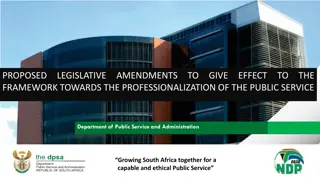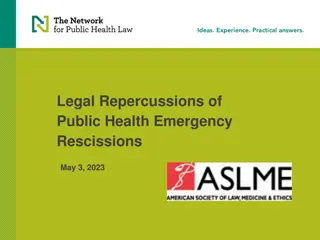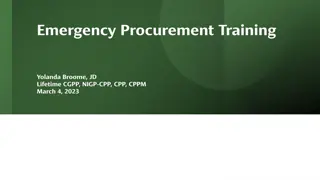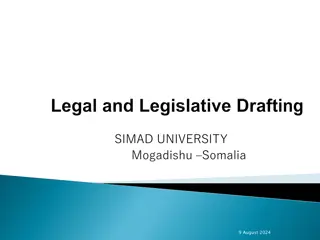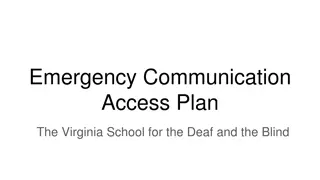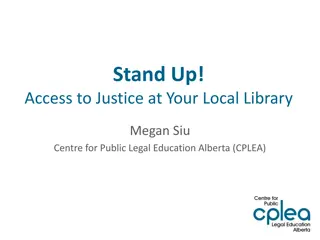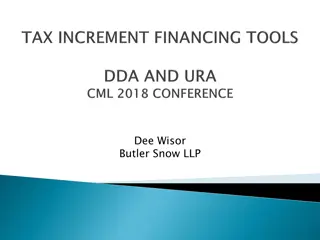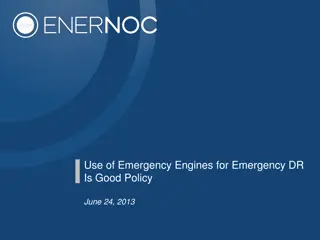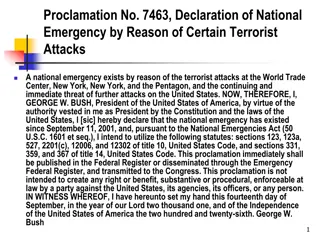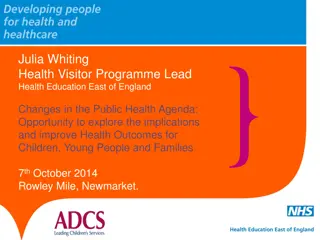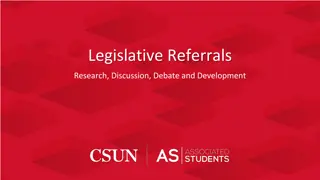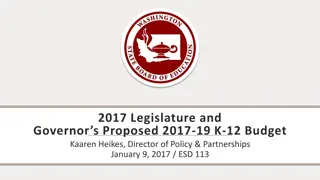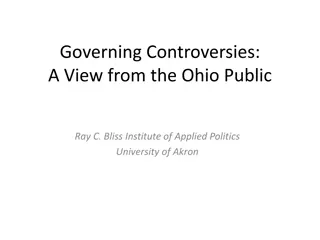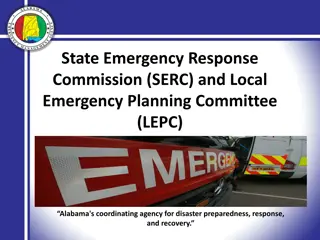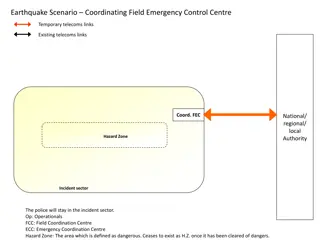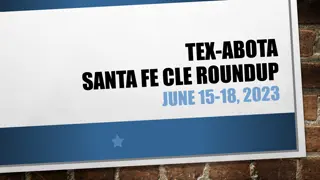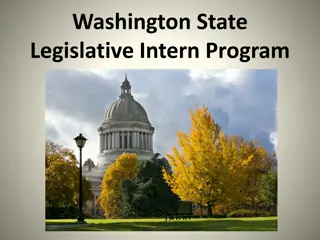The End of Public Health Emergency: Legal Authorities and Legislative Actions
The public health emergency declaration for COVID-19 preparedness summit is coming to an end, with various legal authorities and legislative actions in place. The complex environment includes multiple emergency declarations, administrative actions, and legislation changes. Different declarations have different end dates and allow for specific provisions. Legislative actions tied to the public health emergency include the Families First Coronavirus Response Act, Coronavirus Aid, Relief, and Economic Security Act, American Rescue Plan Act, and more.
Uploaded on Sep 12, 2024 | 0 Views
Download Presentation

Please find below an Image/Link to download the presentation.
The content on the website is provided AS IS for your information and personal use only. It may not be sold, licensed, or shared on other websites without obtaining consent from the author. Download presentation by click this link. If you encounter any issues during the download, it is possible that the publisher has removed the file from their server.
E N D
Presentation Transcript
The End of the Public Health Emergency Declaration for COVID-19 Preparedness Summit April 24, 2023 Jen Kates (jkates@kff.org) The independent source for health policy research, polling, and news.
Its not just the PHE: The larger environment is complex Multiple Emergency Declarations Several Administrative Actions Multiple Pieces of Legislation Some changes decoupled from PHE, some made permanent Not All Their Declarations Are Ending interaction is complex kff.org
Declaration Legal Authority Declared Duration End Date What it Allows For Section 319 of Public Health Service Act January 2020 Until Secretary declares that PHE no longer exists or 90 days from declaration May 11, 2023 Allows HHS Secretary to make grants, enter into contracts, detail staff and supplies, use funds appropriated to the Public Health Emergency Fund, waive/modify certain Medicaid/CHIP, Medicare requirements. Public Health Emergency 319 Declaration Section 564 of Federal Food, Drug, and Cosmetic (FD&C) Act February 2020 Remains in effect until terminated by Secretary Not yet specified Allows FDA to issue emergency use authorizations for medical countermeasures (vaccines, tests, treatments). Public Health Emergency 564 Declaration Section 201 of National Emergencies Act March 2020 In effect unless terminated by or not renewed annually by the President, or via joint resolution of Congress May 11, 2023 Allows President to invoke standby authorities (e.g., Defense Production Act). National Emergency Declaration Section 319F-3 of Public Health Service Act March 2020 Variable Variable. Many through Oct 2024 but to be extended through Dec 2024 Allows HHS Secretary to provide liability immunity for medical countermeasures (e.g., to pharmacists & other health care providers). PREP Act Declaration Section 501(b) of Robert T. Stafford Disaster Relief and Emergency Assistance Act March 2020 Until FEMA ends incident period May 11, 2023 Authorizes FEMA assistance (Public Assistance Program, individual assistance). Stafford Act Declaration kff.org
Legislative and Administrative Actions (some tied to PHE) Select Legislation Administrative Actions Families First Coronavirus Response Act (FFCRA) Federal purchase of vaccines, tests, treatments to provide free of charge to all Coronavirus Aid, Relief, and Economic Security (CARES) Act 8 free home tests per month American Rescue Plan Act (ARPA) Private insurers required to reimburse out-of-network providers for vaccine administration Inflation Reduction Act (IRA) Consolidated Appropriations Act (CAA), 2023 kff.org
COVID-19 Vaccines What Changes? What Remains the Same? Private plans/issuers no longer required to cover COVID-19 vaccines without cost-sharing even when out-of-network. As long as federally purchased vaccines last, COVID- 19 vaccines will remain free to all. After supply is gone, due to the Affordable Care Act, as well as CARES, ARPA, and IRA, vaccines will continue to be free to almost everyone with private and public insurance (though those with private insurance may face cost-sharing out-of-network). Temporary Medicaid option (adopted by 18 states) to provide uninsured with free COVID-19 vaccines ends. 100% federal Medicaid matching payments for vaccine administration end after September 2024* (due to ARPA); then regular match. Those who are uninsured will have no guaranteed access (on April 18, HHS announced a new Bridge Access Program For COVID-19 Vaccines and Treatments to help address this issue but full details are not available and there is no ongoing guarantee). BUT, for consumers, vaccines still free of charge while federal supply lasts (and for most thereafter). *Last day of first calendar quarter that begins one year after last day of PHE. kff.org
COVID-19 At-Home Tests What Changes? What Remains the Same? End of 8 free tests per month for those with private insurance and Medicare (insurers, including Medicare Advantage plans, may choose to cover home tests, although traditional Medicare cannot). The uninsured in most states were already having to pay for at-home tests unless they were able to access federally purchased tests (no one can be charged for federally purchased tests). People on Medicaid will continue to receive free tests through September 2024* (due to ARPA); then coverage variable by state. Temporary Medicaid option (adopted by 18 states) to provide uninsured with free COVID-19 tests ends. *Last day of first calendar quarter that begins one year after last day of PHE. kff.org
COVID-19 PCR/Provider-Ordered Tests What Changes? What Remains the Same? Traditional Medicare beneficiaries will continue to receive provider ordered tests at no-cost (though there may be cost-sharing for visit). Although most insured people will still have coverage for COVID tests ordered or administered by a health professional, they may face cost-sharing for tests or testing-related services and there could be new limits. The uninsured in most states were already having to pay for tests unless they were able to access federally purchased tests (no one can be charged for federally purchased tests). People on Medicaid will continue to receive free tests with no-cost sharing through September 2024* (due to ARPA); then cost-sharing variable by state. Temporary Medicaid option (adopted by 18 states) to provide uninsured with free COVID-19 tests ends. *Last day of first calendar quarter that begins one year after last day of PHE. kff.org
COVID-19 Treatments (outpatient drugs and hospitalizations) What Changes? What Remains the Same? Medicare beneficiaries may face cost-sharing for certain treatments (unless federal supply). Any treatment doses (e.g., Paxlovid) purchased by the federal government are still free to all, regardless of insurance coverage. People on Medicaid will continue to receive free treatments with no-cost sharing through September 2024* (due to ARPA); then cost-sharing variable by state. Most insured people already faced cost-sharing for hospitalizations and outpatient visits related to COVID treatment. Temporary Medicaid option (adopted by 18 states) to provide uninsured people with free COVID-19 treatments ends. After federal supply is gone, the uninsured have no guaranteed access (on April 18, HHS announced a new Bridge Access Program For COVID-19 Vaccines and Treatments to help address this issue but full details are not available and there is no ongoing guarantee). End to 20% Medicare payment increase for COVID- 19 hospitalizations. End to Medicare COVID-19 Treatment Add-on Payments after September 30, 2023** *Last day of first calendar quarter that begins one year after last day of PHE. **End of the fiscal year in which the PHE ends kff.org
Telemedicine What Changes? What Remains the Same? Some flexibilities will end (e.g., in-person visits will be required for controlled substances*), and some states have tied telehealth flexibilities, such as state licensure, to the PHE. Medicare beneficiaries will have access to expanded telehealth coverage through December 31, 2024 (due to CAA, no longer tied to PHE). Temporary waiver of penalties against providers using technologies that don t comply with federal privacy and security rules (i.e., HIPAA) in the provision of telehealth services will end. Private coverage varies though most private insurers already covered telehealth before the pandemic. Most states have made, or plan to make, some Medicaid telehealth flexibilities permanent. *Proposed rules to make telehealth flexibility permanent. kff.org
Other Health Provisions/Flexibilities Ending Due to End of PHE Medicaid Waivers Section 1135 waivers end on May 11, 2023. Medicaid Disaster-Relief State Plan Amendments end no later than July 10, 2023, 60 days after end of PHE. Section 1915c Appendix K Waivers for Home and Community Based Services (HCBS) end no later than November 11, 2023, 6 months after end of PHE. Data Reporting requirements HHS will no longer have authority to require reporting of COVID-19 laboratory data after May 11, 2023, as specified in the CARES Act. (CDC is also working to update all Data Use Agreements for COVID-19 vaccination data). Nutrition Benefits Pandemic Electronic Benefits Transfer (EBT) for childcare ends May 11, 2023. States may continue for school kids through September 30, 2023 and the CAA established a permanent summer EBT program. Child and Adult Care Food Program for young adults in shelters ends May 11, 2023. College Student SNAP benefits end after June 9, 2023, 30 days after end of PHE. Title 42 Title 42, which authorizes CDC Director to suspend entry of individuals into U.S. to protect public health, used during COVID-19 to prevent asylum seekers from entering the U.S. Ends May 11, 2023, absent other legal developments. kff.org
Other Health Provisions/Flexibilities Ending but Not Due to End of PHE Medicaid continuous enrollment provision Delinked from PHE by CAA and ended as of March 31, 2023; also phased down enhanced federal matching payments through December 2023. Data Reporting requirements CMS will end requirement that hospitals report COVID-19 data after April 30, 2024. FEMA public assistance support Supplemental grants/reimbursement to state, tribal, territorial, and local governments, certain private non-profits for eligible emergency work during COVID-19 end on May 11, 2023 (due to FEMA announcement of end of incident period). Exceptions for demobilization, disposition, and disposal of equipment and supplies costs, which can be incurred for up to 90 days from end of the emergency work completion deadline, or up until August 9, 2023. FEMA COVID-19 funeral assistance Assistance for individuals extended through September 30, 2025 (due to ARPA). kff.org
PREP Act Declaration Not linked to PHE PREP Act declaration allows for liability (immunity) protections for: Manufacturers, distributors, and providers administering COVID-19 countermeasures (vaccines, tests, treatments) purchased/distributed by federal government. Most protections set to end after October 2024. HHS Secretary intends to amend declaration and extend protections through December 2024 for: Pharmacists, pharmacy interns & techs to administer COVID-19 and flu vaccines to those ages 3 and older and to administer COVID-tests, regardless of any USG agreement or emergency declaration. Provision of COVID-19 countermeasures provided based on a Federal agreement or directly conducted by the USG, including by Federal employees, contractors or volunteers. After products are no longer distributed under USG agreement, protections end for: COVID vaccination by non-traditional providers (e.g., recently retired providers, students). COVID vaccinations across state lines by licensed providers, pharmacists, and pharmacy interns. After PREP Act Declaration is over, protections end for: Routine childhood vaccinations by pharmacists, pharmacy interns, and pharmacy technicians. kff.org
Section 564 Emergency Declaration Not linked to PHE 564 Declaration allows HHS Secretary to permit Emergency Use Authorizations (EUAs) An EUA is a mechanism to facilitate availability and use of medical countermeasures that are determined to be safe and effective but have not yet been formally approved. Declaration remains in effect until terminated by Secretary. Once terminated, products under EUA cannot be distributed in the US. Multiple EUAs have been issued for COVID-19 countermeasures (vaccines, tests, treatments) Many remain under EUA only (not FDA-approved, e.g., Paxlovid). No end date has been announced. kff.org
Final Thought. The End to the PHE has Symbolic effect



